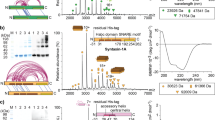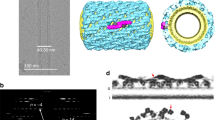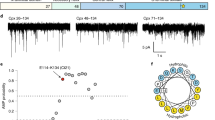Abstract
Neurotransmission relies on synaptic vesicles fusing with the membrane of nerve cells to release their neurotransmitter content into the synaptic cleft, a process requiring the assembly of several members of the SNARE (soluble N-ethylmaleimide-sensitive factor attachment protein receptor) family. SNAREs represent an evolutionarily conserved protein family that mediates membrane fusion in the secretory and endocytic pathways of eukaryotic cells1,2,3. On membrane contact, these proteins assemble in trans between the membranes as a bundle of four α-helices, with the energy released during assembly being thought to drive fusion4,5,6. However, it is unclear how the energy is transferred to the membranes and whether assembly is conformationally linked to fusion. Here, we report the X-ray structure of the neuronal SNARE complex, consisting of rat syntaxin 1A, SNAP-25 and synaptobrevin 2, with the carboxy-terminal linkers and transmembrane regions at 3.4 Å resolution. The structure shows that assembly proceeds beyond the already known core SNARE complex7, resulting in a continuous helical bundle that is further stabilized by side-chain interactions in the linker region. Our results suggest that the final phase of SNARE assembly is directly coupled to membrane merger.
This is a preview of subscription content, access via your institution
Access options
Subscribe to this journal
Receive 51 print issues and online access
$199.00 per year
only $3.90 per issue
Buy this article
- Purchase on Springer Link
- Instant access to full article PDF
Prices may be subject to local taxes which are calculated during checkout




Similar content being viewed by others
References
Martens, S. & McMahon, H. T. Mechanisms of membrane fusion: disparate players and common principles. Nature Rev. Mol. Cell Biol. 9, 543–556 (2008)
Jahn, R. & Scheller, R. H. SNAREs–engines for membrane fusion. Nature Rev. Mol. Cell Biol. 7, 631–643 (2006)
Rizo, J. & Rosenmund, C. Synaptic vesicle fusion. Nature Struct. Mol. Biol. 15, 665–674 (2008)
Pelham, H. R., Banfield, D. K. & Lewis, M. J. SNAREs involved in traffic through the Golgi complex. Cold Spring Harb. Symp. Quant. Biol. 60, 105–111 (1995)
Hanson, P. I., Heuser, J. E. & Jahn, R. Neurotransmitter release — four years of SNARE complexes. Curr. Opin. Neurobiol. 7, 310–315 (1997)
Lin, R. C. & Scheller, R. H. Structural organization of the synaptic exocytosis core complex. Neuron 19, 1087–1094 (1997)
Sutton, R. B., Fasshauer, D., Jahn, R. & Brunger, A. T. Crystal structure of a SNARE complex involved in synaptic exocytosis at 2.4 Å resolution. Nature 395, 347–353 (1998)
Brunger, A. T. Structure and function of SNARE and SNARE-interacting proteins. Q. Rev. Biophys. 38, 1–47 (2005)
Kloepper, T. H., Kienle, N. C. & Fasshauer, D. An elaborate classification of SNARE proteins sheds light on the conservation of the eukaryotic endomembrane system. Mol. Biol. Cell 18, 3463–3471 (2007)
Fasshauer, D. et al. A structural change occurs upon binding of syntaxin to SNAP-25. J. Biol. Chem. 272, 4582–4590 (1997)
Fasshauer, D. et al. Structural changes are associated with soluble N-ethylmaleimide-sensitive fusion protein attachment protein receptor complex formation. J. Biol. Chem. 272, 28036–28041 (1997)
Sorensen, J. B. et al. Sequential N- to C-terminal SNARE complex assembly drives priming and fusion of secretory vesicles. EMBO J. 25, 955–966 (2006)
Pobbati, A. V., Stein, A. & Fasshauer, D. N- to C-terminal SNARE complex assembly promotes rapid membrane fusion. Science 313, 673–676 (2006)
Su, Z., Ishitsuka, Y., Ha, T. & Shin, Y. K. The SNARE complex from yeast is partially unstructured on the membrane. Structure 16, 1138–1146 (2008)
Dennison, S. M., Bowen, M. E., Brunger, A. T. & Lentz, B. R. Neuronal SNAREs do not trigger fusion between synthetic membranes but do promote PEG-mediated membrane fusion. Biophys. J. 90, 1661–1675 (2006)
Jackson, M. B. & Chapman, E. R. Fusion pores and fusion machines in Ca2+-triggered exocytosis. Annu. Rev. Biophys. Biomol. Struct. 35, 135–160 (2006)
Rizo, J., Chen, X. & Arac, D. Unraveling the mechanisms of synaptotagmin and SNARE function in neurotransmitter release. Trends Cell Biol. 16, 339–350 (2006)
Fasshauer, D., Antonin, W., Subramaniam, V. & Jahn, R. SNARE assembly and disassembly exhibit a pronounced hysteresis. Nature Struct. Biol. 9, 144–151 (2002)
Poirier, M. A. et al. Protease resistance of syntaxin·SNAP-25·VAMP complexes. Implications for assembly and structure. J. Biol. Chem. 273, 11370–11377 (1998)
Ernst, J. A. & Brunger, A. T. High resolution structure, stability, and synaptotagmin binding of a truncated neuronal SNARE complex. J. Biol. Chem. 278, 8630–8636 (2003)
Lam, A. D. et al. SNARE-catalyzed fusion events are regulated by syntaxin1A–lipid interactions. Mol. Biol. Cell 19, 485–497 (2008)
McNew, J. A. et al. The length of the flexible SNAREpin juxtamembrane region is a critical determinant of SNARE-dependent fusion. Mol. Cell 4, 415–421 (1999)
Wang, Y., Dulubova, I., Rizo, J. & Sudhof, T. C. Functional analysis of conserved structural elements in yeast syntaxin Vam3p. J. Biol. Chem. 276, 28598–28605 (2001)
Deak, F., Shin, O. H., Kavalali, E. T. & Sudhof, T. C. Structural determinants of synaptobrevin 2 function in synaptic vesicle fusion. J. Neurosci. 26, 6668–6676 (2006)
Kesavan, J., Borisovska, M. & Bruns, D. v-SNARE actions during Ca2+-triggered exocytosis. Cell 131, 351–363 (2007)
Van Komen, J. S. et al. The polybasic juxtamembrane region of Sso1p is required for SNARE function in vivo . Eukaryot. Cell 4, 2017–2028 (2005)
Fasshauer, D., Sutton, R. B., Brunger, A. T. & Jahn, R. Conserved structural features of the synaptic fusion complex: SNARE proteins reclassified as Q- and R-SNAREs. Proc. Natl Acad. Sci. USA 95, 15781–15786 (1998)
Fasshauer, D., Eliason, W. K., Brunger, A. T. & Jahn, R. Identification of a minimal core of the synaptic SNARE complex sufficient for reversible assembly and disassembly. Biochemistry 37, 10354–10362 (1998)
Schuette, C. G. et al. Determinants of liposome fusion mediated by synaptic SNARE proteins. Proc. Natl Acad. Sci. USA 101, 2858–2863 (2004)
Pobbati, A. V. et al. Structural basis for the inhibitory role of tomosyn in exocytosis. J. Biol. Chem. 279, 47192–47200 (2004)
Fasshauer, D. et al. Mixed and non-cognate SNARE complexes. Characterization of assembly and biophysical properties. J. Biol. Chem. 274, 15440–15446 (1999)
Antonin, W. et al. A SNARE complex mediating fusion of late endosomes defines conserved properties of SNARE structure and function. EMBO J. 19, 6453–6464 (2000)
Brandhorst, D. et al. Homotypic fusion of early endosomes: SNAREs do not determine fusion specificity. Proc. Natl Acad. Sci. USA 103, 2701–2706 (2006)
Stein, A. et al. Synaptotagmin activates membrane fusion through a Ca2+-dependent trans interaction with phospholipids. Nature Struct. Mol. Biol. 14, 904–911 (2007)
Van Duyne, G. D. et al. Atomic structures of the human immunophilin FKBP-12 complexes with FK506 and rapamycin. J. Mol. Biol. 229, 105–124 (1993)
Otwinowski, Z. & Minor, W. Processing of X-ray diffraction data collected in the oscillation mode. Methods Enzymol. 276, 307–326 (1997)
Sheldrick, G. M. A short history of SHELX. Acta Crystallogr. A 64, 112–122 (2008)
Vagin, A. & Teplyakov, A. An approach to multi-copy search in molecular replacement. Acta Crystallogr. D 56, 1622–1624 (2000)
Emsley, P. & Cowtan, K. Coot: model-building tools for molecular graphics. Acta Crystallogr. D 60, 2126–2132 (2004)
Murshudov, G. N., Vagin, A. A. & Dodson, E. J. Refinement of macromolecular structures by the maximum-likelihood method. Acta Crystallogr. D 53, 240–255 (1997)
Winn, M. D., Isupov, M. N. & Murshudov, G. N. Use of TLS parameters to model anisotropic displacements in macromolecular refinement. Acta Crystallogr. D 57, 122–133 (2001)
Adams, P. D. et al. PHENIX: building new software for automated crystallographic structure determination. Acta Crystallogr. D 58, 1948–1954 (2002)
Berendsen, H. J. C., Grigera, J. R. & Straatsma, T. P. The missing term in effective pair potentials. J. Phys. Chem. 91, 6269–6271 (1987)
Kaminski, G. A., Friesner, R. A., Tirado-Rives, J. & Jorgensen, W. L. Evaluation and reparametrization of the OPLS-AA force field for proteins via comparison with accurate quantum chemical calculations on peptides. J. Phys. Chem. B 105, 6474–6487 (2001)
Berger, O., Edholm, O. & Jahnig, F. Molecular dynamics simulations of a fluid bilayer of dipalmitoylphosphatidylcholine at full hydration, constant pressure, and constant temperature. Biophys. J. 72, 2002–2013 (1997)
Hess, B., Kutzner, C., van der Spoel, D. & Lindahl, E. GROMACS 4: Algorithms for highly efficient, load-balanced, and scalable molecular simulation. J. Chem. Theory Comput. 4, 435–447 (2008)
Berendsen, H. J. C. et al. Molecular dynamics with coupling to an external bath. J. Chem. Phys. 81, 3684–3690 (1984)
Hess, B. P-LINCS: A parallel linear constraint solver for molecular simulation. J. Chem. Theory Comput. 4, 116–122 (2008)
Miyamoto, S. & Kollman, P. A. SETTLE: an analytical version of the SHAKE and RATTLE algorithm for rigid water models. J. Comput. Chem. 13, 952–962 (1992)
Acknowledgements
We thank U. Ries for technical assistance, C. Kutzner and H. Grubmüller for providing the model shown in Fig. 4, R. Lührmann for access to his X-ray facilities, D. Fasshauer and N. Pavlos for comments on the manuscript, W. Antonin for providing the expression constructs of endosomal SNAREs and the staff of beamlines PX1 and PX2 of the Swiss Light Source for support during diffraction data collection.
Author Contributions A.S. and R.J. planned the project, A.S. performed the experiments, A.S., G.W. and M.C.W. analysed the data and A.S. and R.J. wrote the manuscript. All authors discussed the results and commented on the manuscript.
Author information
Authors and Affiliations
Corresponding author
Supplementary information
Supplementary Information
This file contains Supplementary Figures S1-S4 with Legends, Supplementary Table 1 and a Supplementary Reference. (PDF 637 kb)
Rights and permissions
About this article
Cite this article
Stein, A., Weber, G., Wahl, M. et al. Helical extension of the neuronal SNARE complex into the membrane. Nature 460, 525–528 (2009). https://doi.org/10.1038/nature08156
Received:
Accepted:
Published:
Issue Date:
DOI: https://doi.org/10.1038/nature08156
This article is cited by
-
Mechanisms of SNARE proteins in membrane fusion
Nature Reviews Molecular Cell Biology (2024)
-
Identification of residues critical for the extension of Munc18-1 domain 3a
BMC Biology (2023)
-
Vesicle trafficking and vesicle fusion: mechanisms, biological functions, and their implications for potential disease therapy
Molecular Biomedicine (2022)
-
Conformational change of Syntaxin-3b in regulating SNARE complex assembly in the ribbon synapses
Scientific Reports (2022)
-
Cross-linking mass spectrometry uncovers protein interactions and functional assemblies in synaptic vesicle membranes
Nature Communications (2021)
Comments
By submitting a comment you agree to abide by our Terms and Community Guidelines. If you find something abusive or that does not comply with our terms or guidelines please flag it as inappropriate.



